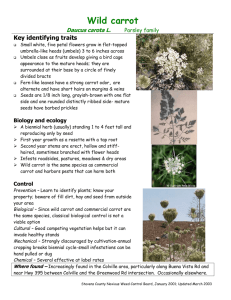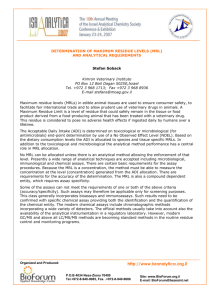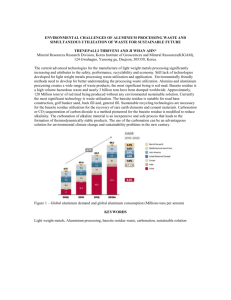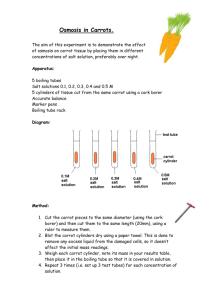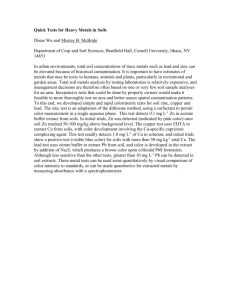Content - Agricultural Technology an International Journal
advertisement
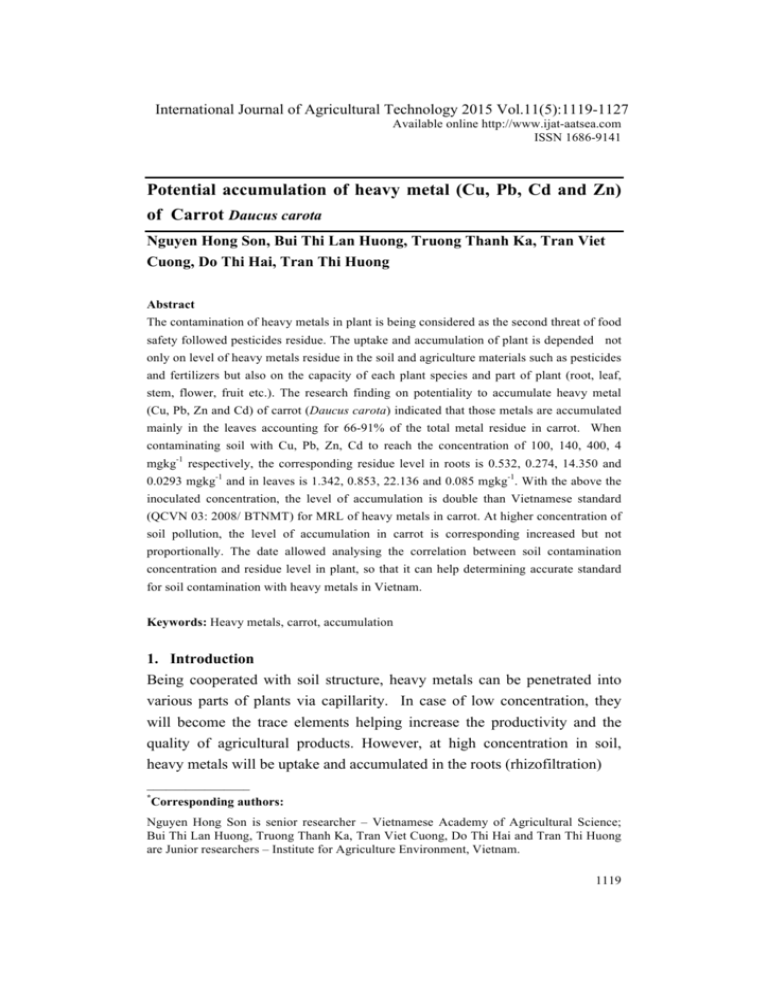
International Journal of Agricultural Technology 2015 Vol.11(5):1119-1127 Available online http://www.ijat-aatsea.com ISSN 1686-9141 Potential accumulation of heavy metal (Cu, Pb, Cd and Zn) of Carrot Daucus carota Nguyen Hong Son, Bui Thi Lan Huong, Truong Thanh Ka, Tran Viet Cuong, Do Thi Hai, Tran Thi Huong Abstract The contamination of heavy metals in plant is being considered as the second threat of food safety followed pesticides residue. The uptake and accumulation of plant is depended not only on level of heavy metals residue in the soil and agriculture materials such as pesticides and fertilizers but also on the capacity of each plant species and part of plant (root, leaf, stem, flower, fruit etc.). The research finding on potentiality to accumulate heavy metal (Cu, Pb, Zn and Cd) of carrot (Daucus carota) indicated that those metals are accumulated mainly in the leaves accounting for 66-91% of the total metal residue in carrot. When contaminating soil with Cu, Pb, Zn, Cd to reach the concentration of 100, 140, 400, 4 mgkg-1 respectively, the corresponding residue level in roots is 0.532, 0.274, 14.350 and 0.0293 mgkg-1 and in leaves is 1.342, 0.853, 22.136 and 0.085 mgkg-1. With the above the inoculated concentration, the level of accumulation is double than Vietnamese standard (QCVN 03: 2008/ BTNMT) for MRL of heavy metals in carrot. At higher concentration of soil pollution, the level of accumulation in carrot is corresponding increased but not proportionally. The date allowed analysing the correlation between soil contamination concentration and residue level in plant, so that it can help determining accurate standard for soil contamination with heavy metals in Vietnam. Keywords: Heavy metals, carrot, accumulation 1. Introduction Being cooperated with soil structure, heavy metals can be penetrated into various parts of plants via capillarity. In case of low concentration, they will become the trace elements helping increase the productivity and the quality of agricultural products. However, at high concentration in soil, heavy metals will be uptake and accumulated in the roots (rhizofiltration) ________________ * Corresponding authors: Nguyen Hong Son is senior researcher – Vietnamese Academy of Agricultural Science; Bui Thi Lan Huong, Truong Thanh Ka, Tran Viet Cuong, Do Thi Hai and Tran Thi Huong are Junior researchers – Institute for Agriculture Environment, Vietnam. 1119 International Journal of Agricultural Technology 2015 Vol.11(5):1119-1127 or fixed in the plant biomass (phytostabilization). In some cases, heavy metals are transported to the plant branches and leaves and stored in the vacuole or probably eliminated into the environment via stoma in the form of salt under the leaf surface (phytoextraTion) [4]. Carrot (Daucus carota) is important vegetable being consumed very popularly in both fresh and cooking. The research finding of Boamponsem (2012) indicated that the cultivation of carrot on clean soil and irrigating with wastewater contaminated with heavy metals, the residue of Cd in leaves, roots and stem is 0.071, 0.058 and 0.082 mgkg-1; Cu residue is 0.221, 0.143 and 0.092 mgkg-1 respectively. Singh (2012) also reported that the cultivation of some vegetable including carrot in heavy metal contaminated soil, the accumulation level was changed between different metals. In carrot, the accumulation of Zn in roots, leaves is 28 and 52mgkg1, while accumulation of Cu is 13 and 16 mgkg-1; Pb is 15 and 22 mgkg-1; Cd is 2 and 3 mgkg-1. In Vietnam, there have been some studies on the potential accumulation of heavy metals in some vegetables such as watercress (Nasturtium officinale), spinach (Ipomoea aquatica), small colza (Brassica juncea), but no study on carrot. The national standard is mainly based of reference data for vegetable only. This research aims to determine the correlation between soil contamination concentration and residue level in plant, so that it can help adjusting standard for soil contamination with heavy metals for carrot cultivation in Vietnam. 2. Materials and methods • Soil: the alluvial soil taken from the Red River delta, then dried under the sunlight and grinded into small sieves of 2mm to remove stones and gravel. After that the soil is incubated at the humidity of 60-70%. • Heavy metals: Cu, Pb, Zn and Cd from the salty forms of Cu(NO3)2; Pb(NO3)2; Zn(NO3)2; Cd(NO3)2. 1120 Received 28 February 2015; Accepted 30 June 2015 International Journal of Agricultural Technology 2015 Vol.11(5):1119-1127 Contamination method - Step 1: determining the concentration of Cu, Pb, Zn and Cd in the soil after being crushed (control treatment in Table 1) - Step 2: dividing the soil into small piles - Step 3: diluting salts of heavy metals in water - Step 4: contaminating by spraying dilution at appropriate concentration of each treatment: Control - maintaining available concentration of the soil; Treatment 2 (T1): current standard (QCVN 03: 2008/ BTNMT) for vegetable cultivation; Treatment 3, 4, 5 (T2; T3; T4): 1.5; 2.0 and 3.0 times of T1 - Step 5: incubating contaminated soil in room temperature during 15 days, then sifting through a sieve of 2mm and moved to Styrofoam boxes sized 40 cm x 45 cm x 60 cm, 3 boxes/ each treatment. Table 1. Summary of treatments Treatment Heavy metal concentration (mgkg-1) Cu Pb Cd Zn Control 38.4 51.2 0.93 107.8 T1 50 70 2 200 T2 75 105 3 300 T3 100 140 4 400 T4 150 210 6 600 Growing of carrot in heavy metals incubated boxes 1121 International Journal of Agricultural Technology 2015 Vol.11(5):1119-1127 • Plants: planting 6 seedlings in each Styrofoam box and remaining normal growing condition in greenhouse. • Sampling: is undertaken at 3 months after planting. All plants are slowly taken out of the ground, then soaked in the glass jar containing distilled water from 30 to 45 minutes. Using soft brush and rinse out the outside soil layer, then separating the roots and leaves and putting in polyethylene bags. • Specimen preservation: the specimen is chopped into small and put into the paper bags and dried at the temperatures of 800 degree from 12 - 24 hours. After being dried, the sample will be crushed and stored in sealed plastic bags. • Measurement and analysis: weight 1g of crushed specimen and put into porcelain cup, then heating at 5500 degree Celsius within 4-8 hours (until the specimen completely turn into the white milk color). After drying, the specimen is cooled and mixed in 50 ml of mixture of HNO3: HCl at ratio of 1: 3, then filtering and measuring on the AAS machine. For soil specimen using destructive methods using acid mixture of HNO3 and H2SO4 then measuring on AAS machine. 3. Results and discussion 3.1. The accumulation of heavy metal in different parts of carrot It is clearly recognized from research findings presented in table 2, 3, 4 and 5 that the accumulation of heavy metal in carrot is mainly allocated in the leaves. The residue contained in root is much lower. For example, the accumulation of Cu in root accounted for 16.97-33.91% of the total while its residue in leaves is 66.09-83.03% (Table 2). In similarity, the accumulation of Pb, Zn and Cd in root takes only 24.11-30.19; 26.8439.33; 8.95-25.37% of the total residue in carrot where as leaves can uptake those metals up to 69.81-75.89; 60.67-73.16 and 73.64-91.05% respectively (Table 3, 4 and 5). This finding was coincided with the research of Boamponsem (2012) and Singh (2012) on carrot. According to those authors, the mechanism to uptake and accumulate heavy metals of carrot is extraction (phytoextraction). The acceptable heavy metals adsorbed by the plant are moved to the top parts of the plant (branches, leaves) via the xylem cell. 1122 Received 28 February 2015; Accepted 30 June 2015 International Journal of Agricultural Technology 2015 Vol.11(5):1119-1127 Table 2. Accumulation of Cu in roots and leaves of carrot Treatment Residue level (mgkg-1 of dry biomass) Proportion of the total accumulation (%) MRL (mgkg-1 ) In root In leaves Total In roots In leaves Control 0.39 0.76 1.15 33.91 66.09 TCVN T1 0.28 1.37 1.65 16.97 83.03 99/2008: T2 0.41 1.05 1.46 28.08 71.92 2.0 T3 0.42 1.47 1.89 22.22 77.78 WHO 19- T4 0.53 1.34 1.87 28.34 71.66 93: 0,5 Legend: T: Treatment Table 3. Accumulation of Pb in roots and leaves of carrot Treatment Residue level (mgkg-1 of dry biomass) Proportion of the total accumulation (%) In root In leaves Total In roots In leaves Control 0.16 0.37 0.53 30.19 69.81 T1 0.19 0.49 0.68 27.94 72.06 T2 0.23 0.71 0.94 24.47 75.53 T3 0.27 0.75 1.03 27.18 72.82 T4 0.28 0.85 1.12 24.11 75.89 MRL (mgkg-1 ) TCVN 99/2008 0.1; FAO:0.5 Legend: T: Treatment Table 4. Accumulation of Zn in roots and leaves of carrot Treatment Residue level (mgkg-1 of dry biomass) Proportion of the total accumulation (%) MRL (mgkg-1 ) In root In leaves Total In roots In leaves Control 3.60 8.10 11.70 30.77 69.23 TCVN T1 5.98 13.55 19.53 30.62 69.38 99/2008: T2 6.57 17.91 24.48 26.84 73.16 40.0; T3 9.37 20.91 30.28 30.94 69.06 FAO: T4 14.35 22.14 36.49 39.33 60.67 10.0 Legend: T: Treatment 1123 International Journal of Agricultural Technology 2015 Vol.11(5):1119-1127 Table 5. Accumulation of Cd in roots and leaves of carrot Treatment Residue level (mgkg-1 of dry biomass) Proportion of the total accumulation (%) MRL (mgkg-1 ) In root In leaves Total In roots In leaves Control 0.0022 0.0213 0.0235 9.36 90.64 TCVN T1 0.0064 0.0322 0.0386 16.58 83.42 99/2008: T2 0.0074 0.0753 0.0827 8.95 91.05 1.00; T3 0.0156 0.0654 0.0810 19.26 80.74 FAO: T4 0.0290 0.0853 0.1143 25.37 74.63 0.02 Legend: T: Treatment 3.2. Accumulation of different metals by carrot For the level of accumulation, it is also indicated that the highest concentrations accumulated in the plant is Zn, next to Cu, Pb and Cd. While the total of Zn residue in both leaves and root of carrot is ranged from 11.70-36.49mgkg-1(Table 2), the residue level of Cu, Pb and Cd is relatively ranged 1.15 – 1.87; 0.53 – 1.12 and 0.0235 – 0.1143 mgkg-1 depending on the experimental concentrations (Table 3, 4 and 5). Although the residue level increased in accordant with the higher incubated concentration of metals, it is not proportionally in all cases. The total residue and residue accumulated in each part of plant may be inversely with incubated concentration in some cases. It means the potential uptake and accumulation of carrot may be contributed by both metal concentration in the soil and self-defense mechanism of the plant. When the heavy metal concentration is high, the plant will secrete enzymes with the essential components of proteins in the root zone. These substances become the heavy metal retention in the root zone preventing from penetrating the plant. This mechanism is called the phytolignification (a type of fixed mechanism). 1124 Received 28 February 2015; Accepted 30 June 2015 International Journal of Agricultural Technology 2015 Vol.11(5):1119-1127 Although plant has no demand of Cd, it may uptake and accumulate Cd passively as "wrong sucking" in case of lacking Zn meanwhile Cd contaminated at very high concentration in the soil. 3.3. Potential food poison with heavy metals residue in carrot It is indicated from date recorded that the total residue level of all of experiment metals is lower than MRL regulated by FAO or Vietnamese standard (TCVN) when the incubated concentraion of heavy metals is 2 times higher TCVN standard of heavy metal permited in soil. When incubating at higher concentration (3 times compared with standard), residue of heavy metals will be exceeded the MRL. However, the residue in root, a harvesting part of carrot is almost not over MRL. The total residue level of Cu is higher than WHO but lower TCVN standard. The residue in root exceeds WHO standard but is lower TCVN when incubating soil at the concentration of 3 times over TCVN (0.53 compared with 0.50 and 2.0mgkg-1 of WHO and TCVN respectively) – Table 2. The total residue of Pb exceeds both FAO and TCVN standard, but root accumulates lower residue than FAO (0.16 – 0.28 mgkg-1 compared to 0.5mgkg-1) - Table 3. Where as the residue of Zn and Cd in the root is lower than FAO standard when incubating soil at the concentration lower than 2 times of TCVN standard, it is higher than FAO standard when incubating at 3 times (14.35 compared with 10.0 mgkg-1 for Zn and 0.0290 compared with 0.02 mgkg-1 for Cd). In all cases, the total residue and root residue of Zn and Cd is much lower than TCVN, but total residue is higher than FAO standard (Table 4 and 5). 4. Conclusion • The accumulation of heavy metal in carrot is mainly allocated in the leaves, accounting for 66.09-83.03% total residue of Cu; 69.81-75.89%; 1125 International Journal of Agricultural Technology 2015 Vol.11(5):1119-1127 60.67-73.16% and 73.64-91.05% total residue of Pb, Zn and Cd respectively depending on the soil concentration of appropriate metal. • Carrot showed the highest accumulation potentiality to Zn, next to Cu, Pb and Cd. Although the residue level increased in accordant with the higher incubated concentration, it is not proportionally in all cases. • Although plant has no demand of Cd, it may uptake and accumulate Cd passively as "wrong sucking" in case of lacking Zn meanwhile Cd contaminated at very high concentration in the soil. • Although the total residue level of some heavy metal may exceed MRL regulated by FAO or Vietnamese standard (TCVN), the root residue of all metals does not exceed those standards when soil contaimination concentration is double than TCVN. References 1. G.A. Boamponsem, M. Kumi, I. Debrah, “Heavy metals accumulation in cabbage, lettuce and carrot irrigated with wastewater from nagodi mining site in ghana ”; International journal of scientific and technology research volume 1, issue 11, December 2012, ISSN 2277-8616. 2. QCVN 03:2008/BTNMT: National technical regulation on the allowable limits of metals in the soils 3. Introduction to phytoremediation, National risk management research laboratory office of research and development, US environmental protection agency. 4. S. Singh*, M. Zacharias, S. Kalpana and S. Mishra, Heavy metals accumulation and distribution pattern in different vegetable crops Journal of Environmental Chemistry and Ecotoxicology Vol. 4(10), pp. 170-177, July 2012 1126 Received 28 February 2015; Accepted 30 June 2015 International Journal of Agricultural Technology 2015 Vol.11(5):1119-1127 5. Sotiris Stasinos, Ioannis Zabetakis; The uptake of nickel and chromium from irrigation water by potatoes, carrots and onions; Ecotoxicology and Environmental Safety 91 (2013) 122-128 6. TCVN 99/2008/QĐ-BNN 1127

